In part one of the golf mechanics series, we discussed the relative demand of motion at each joint and the movement patterns as they relate to golf swing mechanics. In part two of the golf mechanics series, we reviewed the three planes of motion and exercises to develop mobility and strength to support the ideal golf swing. Now that you’ve improved your joint mobility, this third and final part of the golf mechanics series specifically focuses on adding rotational power to the golf swing. Power is developed through the combination of strength and speed. While safety and proper form is the priority with any strength training exercise, the exercises below are intended to be done quickly to develop type 2, fast-twitch muscle fibers (large muscle fibers that contract without oxygen during intense, short-duration bouts of activity). Developing more type 2 muscle fibers will directly increase power in your golf swing. Continue reading for exercises to incorporate into your golf-specific exercise programming.
Wall Ball Exercises
overhead (extension) wall toss
- Stand close to wall (6-8 inches), square your hips, and hold the medicine ball overhead. Extend through low back and use power of trunk, core muscles and straight arms to slam ball against the wall. Complete 2 rounds of 30 reps.
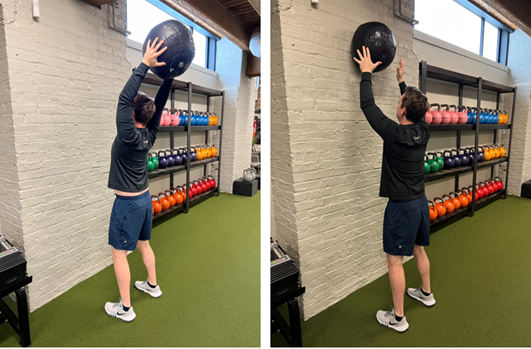
Parallel wall toss
- Stand facing the wall (12-16 inches), square your hips, and hold the medicine ball with both hands. Rotate trunk to bring the medicine ball on the outside of your right hip then quickly squeeze glutes to powerfully release medicine ball into the wall. Catch the ball and load the medicine ball into the opposite (left hip). Repeat for 3 rounds of 10 reps per side.
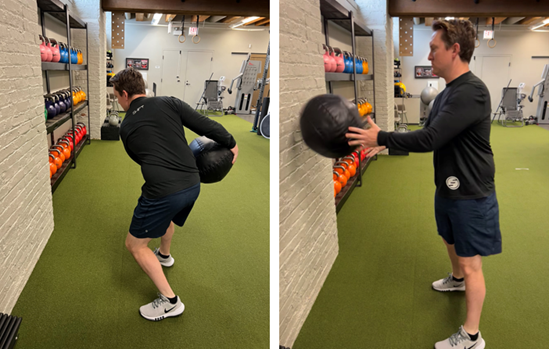
perpendicular or rotational power wall toss
- Stand sideways to the wall and hold medicine ball in both hands. Twist trunk away from wall, bring the medicine ball to the outside of the right hip, then push-off with right leg as you quickly release the ball toward the wall. The loading portion of the movement should be done slowly but the release is done quickly and with power. Complete 3 rounds of 10 reps per side.
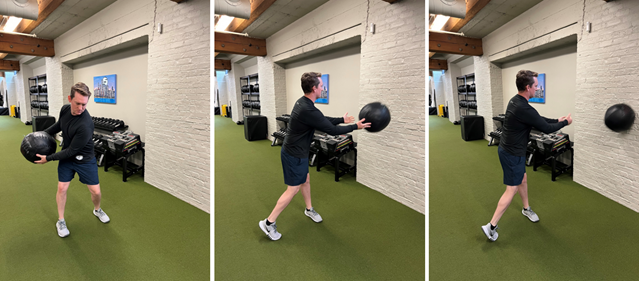
Chop and lift exercises
The chop and lift exercises are proprioceptive neuromuscular facilitation (PNF) patterns that move the body through a diagonal pattern and stimulate a reflexive response of core muscles to appropriately stabilize the body. The tri-planar movements require the integration of multiple musculoskeletal joints and muscle groups to complete the movement. There are several variations to both the chop and the lift exercise. The split lunge foot placement variation creates a narrow base of support that increases both core and hip activation to maintain balance through the activity.
chops
- Start with the resistance band or cable column weight above shoulder height. Turn perpendicular to the anchor point. Place the right (inside) leg forward into a lunge position and the left (outside) leg backward with the heel lifted off the ground. Lean chest slightly forward and distribute most of the weight forward into the front leg. Once stable, hold the resistance with both hands, engage core, keep arms straight as you rotate your trunk down toward the right hip. Pause at the bottom for a full contraction and slowly release the resistance back to original position. The power in the movement comes from the quick but controlled downward rotation. Complete 10 reps then turn to face the opposite direction and complete on the other side. Complete 3 rounds per side in each workout.
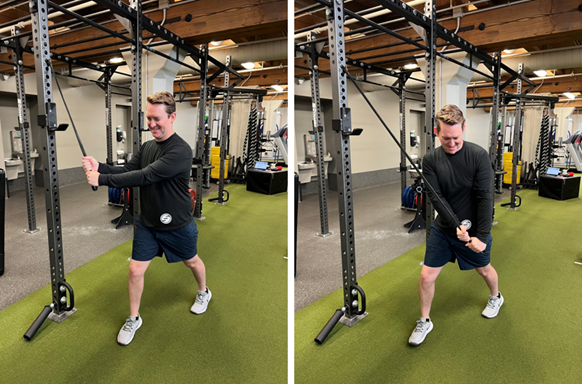
lifts
- Start with resistance band or cable column at a height below knee level. Turn perpendicular to the anchor point. Place the left (outside) leg forward and right (inside) leg backward with the heel off the ground to achieve a split lunge position. Distribute most of the weight into the right leg. Once stable, hold the resistance with both hands, engage your core, keep arms straight as you rotate trunk forward and away from the anchor point. The finish point should be above and outside the right shoulder. Hold this position for a second before returning to the original position. Complete each repetition with power originating from the abdominals and obliques. Complete 10 reps then turn to face the opposite direction to complete on the other side. Complete 3 rounds per side in each workout.
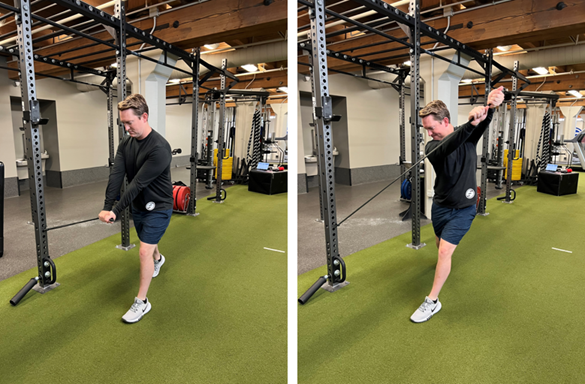
Rotation occurs as a normal part of daily activity and within a variety of sports. These training exercises develop a greater number of type 2 muscle fibers that contribute to more force and power production for the golf swing. It is crucial that we train these multi-directional movements to optimize our sports performance and minimize the risk for injury. If you have questions about these rotational movements or wish to receive more individualized programming for your golf routine, then please contact Avis (avis.jason@shiftlife.com) or Schedule Physical Therapy Appointment for an in-person assessment and to create a more individualized plan of care.
In Real Health,
Avis Jason, PT, DPT
SHIFT Physical Therapist
